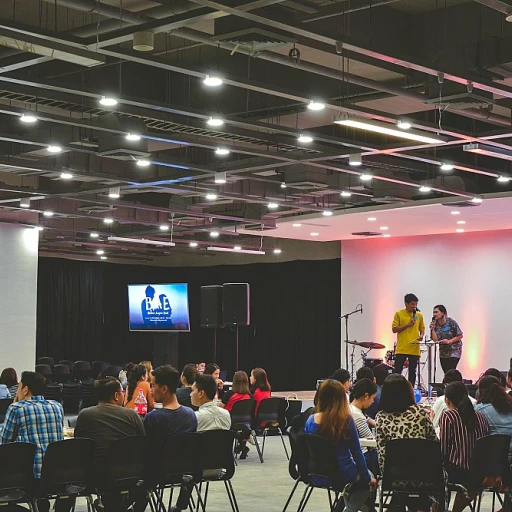Understanding Contingent Talent in the Modern Workforce
Integrating Contingent Talent into the Workforce
In today's fast-paced business environment, the concept of contingent talent has become a crucial component for organizational success. Contingent workers, including freelancers, temporary employees, and independent contractors, provide businesses with the flexibility to adapt and respond to unanticipated staffing needs and market changes.
Contingent workforce management (CWM) is increasingly seen as a vital strategy for companies that want to maintain agility while harnessing diverse skills and expertise. Whether it's addressing short-term project requirements or gaining specific skills, contingent staffing helps companies manage shifts in demand efficiently.
Effective contingent talent management necessitates the use of advanced tools and strategies. Businesses must ensure compliance with labor laws while efficiently managing a blend of traditional and contingent workers. To this end, organizations often employ management software designed to streamline these processes, involving everything from tracking contingent worker experiences to integrating them with full-time employees.
Strategies such as total talent management and direct sourcing are pivotal for optimizing workforce strategy. They allow businesses to leverage the benefits of contingent talent without disrupting the overall flow of operations. As more companies embrace these solutions, there is a growing need to understand the changing dynamics of workforce management. For a deeper dive into how program managers adapt to this shift in an AI-driven HR landscape, you can explore more on the role of program managers in this evolving field.
By equipping your organization with the right tools and strategies, you can manage both contingent and permanent employees effectively, ensuring a cohesive and productive work environment. In the following sections, we will delve into the role of AI in this management process and explore future trends that could redefine how businesses engage with contingent workers.
The Role of AI in Streamlining Talent Acquisition
Revolutionizing Talent Acquisition with AI Tools
The dynamic nature of the modern corporate landscape has made the acquisition of contingent talent a critical need for businesses aiming for adaptability. Artificial intelligence plays a crucial role in transforming how businesses source, evaluate, and onboard contingent workers. By integrating AI-based solutions into their talent pipeline, organizations can streamline talent acquisition processes, increase efficiency, and enhance their compliance and staffing strategies.
AI-driven software solutions have redefined traditional vendor management practices, offering precision in contingent workforce strategy and improving contingent staffing effectiveness. Businesses using AI can better manage vendor relationships, monitoring performance, and ensuring that they engage the right contingent talent swiftly and effectively. This enhances the business's ability to address urgent workforce needs and capitalize on the advantages of contingent staffing.
Moreover, these advanced systems assist in identifying the most suitable workers by matching skills and project requirements. They not only help in sourcing but also support compliance efforts by ensuring that contingent workers meet necessary legal and corporate guidelines. Consequently, AI-powered solutions can significantly minimize the time and resources spent on talent acquisition, enabling permanent employees and contingent workers to function more seamlessly within the organization.
Such AI applications also integrate seamlessly with existing workforce management systems, providing businesses with a comprehensive view of both contingent and full-time workforces. Employing best practices in AI-driven talent management allows businesses to not only enhance their acquisition processes but also to optimize the total talent management approach. By reducing inefficiencies and integrating with broader workforce plans, AI presents a sophisticated contingency staffing solution.
To further explore how AI revolutionizes HR practices, one helpful resource is an article on harnessing AI for effective knowledge management. This provides deeper insights into the nuanced applications of AI in human resources beyond talent acquisition.
Optimizing Workforce Allocation with AI
Embracing Adaptive Workforce Strategies
In the realm of talent management, efficiently managing and optimizing the allocation of contingent talent is crucial for business success. As organizations grapple with evolving workforce needs, they are turning to technology to enhance their contingent workforce management strategies. Enter AI-driven solutions, which promise to revolutionize how businesses deploy and utilize talent.
AI not only facilitates better staffing decisions but also empowers businesses with tools to dynamically adjust workforce allocation. Through comprehensive analysis of skills, availability, and project requirements, AI helps craft the most effective workforce strategy tailored to specific business goals and challenges.
One of the key ways AI optimizes workforce allocation is by analyzing real-time data to predict talent requirements. This allows organizations to maintain an agile approach, efficiently balancing the blend of permanent employees and contingent workers to meet project demands. Such predictive insights not only streamline contingent staffing but also ensure compliance with industry standards.
The incorporation of vendor management systems (VMS) further enhances this process. An AI-powered VMS provides businesses with a centralized platform, allowing for the seamless integration of contingent staffing agencies and direct sourcing efforts. This comprehensive management system can evaluate talent, manage time, and ensure that businesses remain compliant across various regions.
Moreover, AI-driven solutions enable continuous monitoring and analysis of workforce performance. This creates an environment where contingent workers are engaged proactively, and adjustments in staffing can happen swiftly as project needs change. The capacity to swiftly adjust allocations without compromising on quality or productivity is one of the most significant advantages of integrating AI in talent management systems.
For further insights into this impactful transformation in workforce management through AI, you can read more about
understanding the role of AI in job classification, which highlights AI's expansive role in fine-tuning talent strategies for optimal business outcomes.
Empowering Contingent Workers Through Performance Tracking
The introduction of AI in performance management has become a significant asset for businesses aiming to handle their contingent workforce more effectively. By utilizing AI-driven solutions, organizations can optimize the performance management of contingent workers, ensuring that both the project requirements and the personal development needs of the staff are met.
Leveraging management software can assist businesses in tracking key performance indicators, ensuring that contingent talent aligns with the organizational objectives. These systems make it easier to monitor productivity levels, quality of work, and skill development, providing clear insights into the workforce's strengths and areas for improvement.
Automated reports generated through AI solutions facilitate timely feedback, enabling contingent workers to receive real-time insights about their performance. This continuous feedback loop helps in maintaining compliance with industry standards and boosts the morale and engagement of contingent workers. Apart from performance monitoring, AI-driven management software also offers strategies to predict potential challenges, allowing for proactive adjustments in staffing and resource allocation.
Implementing these strategies ensures that businesses can manage both full-time permanent employees and contingent talent seamlessly, supporting a more dynamic and adaptable workforce. With vendor management systems and contingent workforce management solutions, organizations can enhance their talent management efforts, leading to a coherent strategy that benefits all stakeholders involved.
Overall, effectively integrating AI in performance management not only improves the management cwm but also becomes a critical factor in maintaining a competitive edge in contingent staffing.
Challenges and Ethical Considerations in AI-Driven Talent Management
Addressing AI Limitations and Ethical Implications
Integrating artificial intelligence in contingent talent management offers a plethora of benefits to businesses, yet it also introduces potential challenges and ethical considerations. Navigating these obstacles is crucial for optimizing workforce strategies while safeguarding the interests of all stakeholders.
AI can significantly enhance workforce management by streamlining talent acquisition and performance assessments. However, deployment without due diligence might result in unintended biases or mismanagement, affecting contingent workers. A prime concern is the potential for AI to inadvertently perpetuate existing biases in contingent staffing practices. Bias in data or algorithms can skew talent management software outcomes, impacting hiring or workforce allocation decisions.
Moreover, ensuring compliance with legal standards and ethical guidelines is a critical aspect of contingent workforce management. As AI-driven systems increasingly influence decisions, companies must ensure their technology partners, like vendor management solutions or CWM solutions, are rigorously tested for compliance. Post-implementation audits can help mitigate risks, fostering a more equitable working environment for contingent and full-time workers alike.
To manage these challenges, businesses can implement best practices, such as maintaining transparency with contingent workers and continuous monitoring of AI's decision-making processes. Furthermore, companies like symplr that specialize in workforce and talent management software can offer tailored solutions to help organizations effectively manage their contingent workforce while adhering to regulations and ethical standards.
Additionally, strategic human intervention remains indispensable to counterbalance AI's limitations. HR professionals need to collaborate with AI systems to ensure workforce allocation aligns with core business objectives and ethical values. Ultimately, a robust AI strategy includes a blend of technological advancement and human oversight, paving the way for sustainable and ethical contingent workforce management.
Future Trends in AI and Contingent Talent Management
Emerging Trends in AI Applications for Contingent Talent
As businesses continue to adapt to a rapidly changing economic landscape, the integration of AI in contingent workforce management (CWM) displays promising directions, setting new expectations for talent management and acquisition. Various trends are drawing attention, and gaining a competitive edge often means staying ahead of these developments.
One major trend is the increased integration of AI with management software, enabling more efficient workforce management solutions. This comes in handy when managing contingent workers, as businesses aim to streamline talent acquisition processes and improve time oversight. Employing AI can enhance strategic staffing, ensuring contingent workers align with project goals and workforce strategies.
Additionally, solutions focusing on optimizing skills utilization and compliance have become paramount. Solutions like vendor management systems (VMS) and talent management platforms can help manage contingent talent more effectively, ensuring that both compliance requirements and workforce allocation challenges are met. This focus extends to various CWM solutions that are tailored to enhance the contingent staffing strategies of organizations.
In the realm of talent acquisition, AI continues to prove valuable, further enhancing direct sourcing tactics over traditional staffing agencies. By directly engaging with potential contingent workers, businesses can forge a better connection, ultimately resulting in a more agile and adaptable workforce.
Moreover, the balance between contingent workers and permanent employees is evolving with AI's assistance. Innovations in strategy allow businesses to craft a holistic workforce strategy, encompassing both total talent management and niche contingent solutions.
In conclusion, staying informed and adaptable will be crucial for businesses as they navigate these emerging trends in AI-driven contingent talent management. Embracing this technology will necessitate strategic adjustments but promises significant advantages, setting new precedents in workforce flexibility and management.













